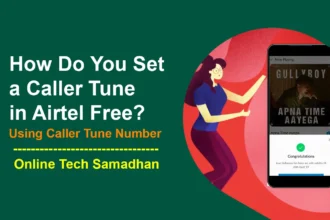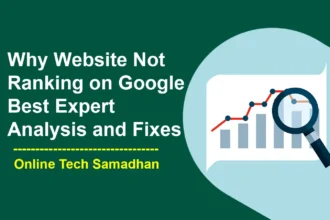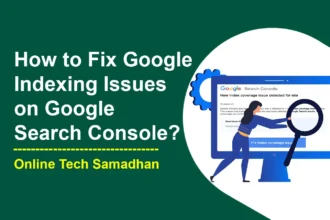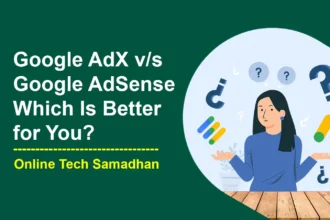Top 17 Strategy How to Recover Website Traffic After Hit the Google Core Update
If you’re a website owner or blogger, you definitely know the importance of Traffic on your Website. It might be upsetting to see a drop in traffic to your website after a Google Core Update. If you want to know How to Recover Website Traffic, focus on making your content more relevant, improving the user experience, and fixing any technical problems.
Make use of resources such as Google Search Console to analyze results and identify areas that want optimization. Keep up with the most current changes in SEO best practices and modify the strategy properly. Utilize social media to communicate with your audience, and provide helpful content on a regular basis to increase or even return to your previous traffic levels.

Remember Recover Traffic After Hitting the Google Core Update you need to follow some of the very important steps to Recover Website Traffic Again.
You May Love To Read
- Banglar Shiksha Portal Login, School Management, Marks Entry 2024
- Google Spreadsheet Download for Windows – Free and Secure
- How to Fix Google Indexing Issues on Google Search Console 2024
- SIP Meaning in Hindi: Key to Achieving Your Financial Goals
- How To Lock iPhone Screen For Kids: Best Expert Guide 2024
What is Google Core Update?
Google upgrades there search engine’s algorithm frequently, which is known as “Google Core Updates. It is a way to improve the standard of search results. The frequency of these modifications affects website rankings in Google Search. The Updates are released usually at the end of every month.

Google Core Updates aim to eliminate low-quality, irrelevant, or spammy content and promote high-quality, informative, useful, and relevant content. Google has offered website owners some basic suggestions to follow with the Google Core Update Release.
How to Identify Google Core Update Hit Your Website?
Since Google doesn’t disclose specific requirements it complies with to make these modifications, it might be difficult to figure out if your website has been affected by one of these updates. However, there are a few basic indicators that can indicate something is wrong with your website. Let’s check the basic indicators that can indicate Google Core Update Hit your Website:

Sudden Drop in Organic Traffic: If you notice a Sudden drop in organic traffic from search engines, especially after a Google Core Update, it could be a sign that your website has been affected.
Changes in Search rankings: If you notice a sudden drop in rankings, it could be an indication that your website’s content or technical aspects no longer align with Google’s updated algorithm.
Increase in negative feedback: It may indicate that your website does not meet Google’s quality requirements if you get more complaints about its performance, such as issues affecting broken links, poor loading times, or irrelevant content.
Google Search Console notifications: You could receive notifications from Google Search Console related to issues with your website, such as crawl faults or manual actions that might be connected to Google Core Updates.
Industry-wide trends: It may be a sign of a larger impact of a Google Core Update if websites in your chosen field are experiencing significant drops in traffic or rankings.
You May Love To Read
- Samsung Galaxy M55 Disadvantages: Is the Samsung Galaxy M55 Right for You?
- How to Create a WhatsApp Channel: A Step-by-Step Guide 2024
- Best Telegram Bot for Students? The Power of Educational Bots
- Citi IndianOil Credit Card: Fuel Your Savings and Rewards
- iQOO 12 5G Launch Date: Set for December 12, Expected Specifications
To check if a Google Core Update has affected your website, you can use Google Search Console to review search performance. Additionally, third-party tools like Semrush, Ahrefs, or Moz can help track rankings and backlinks. If you are connected with industry forums and SEO communities then you will get informed about updates through reputable SEO blogs and news sources.
Best Practices to Increase Website Traffic?
There I have listed my own experienced and effective Practices which increased my new website traffic and recovered the traffic on my old websites which were affected by Google Core Updates.
1. Understand the Core Update:
Now every month Google releases Core Update to Improve User Search Experience. Also, there is a main reason to deliver user quality and informative content from millions of results. Get Information about the Google Core Update from Google’s official blog posts or announcements to gain insights into what changed.
2. Keep Patience and Persistence:
If you realize that your website is hit by Google Core Update then wait for a few days without any crucial changes on your Website. If your Content is well formatted and Informational and provide user with honest and good experiences the automatically again your traffic will automatically increase.
3. Site Monitoring:
Recovery from a Google Core Update can take time. Be patient and continue monitoring your site’s performance and rankings like bounce rate, time on site, and click-through rate (CTR). Make adjustments based on data and feedback from users.
4. Audit Your Website:
After the minimum waiting period if you find an improvement in your traffic then you need to Conduct a comprehensive audit of your website to identify areas that the update may have impacted. Look for changes in rankings, traffic, and user engagement metrics.
5. Identify the Posts or Pages that have been Affected:
You can use Google Analytics, Ahrefs Analytics Plugins, or Google Search Console to identify the posts or pages that have lost ranking and traffic since the update.
6. Analyze the Affected Pages:
Once you know which pages have been affected, you can analyze them to see what might be causing the problem. Look for things like outdated content, AI-generated thin content, irrelevant content, and duplicate content.
7. Make Necessary Changes:
Once you have identified the problems, you can make the necessary changes to improve the quality of the pages. This may include updating the old content, adding more information on content, or removing duplicate content and AI Content.
8. Quality Assurance:
Regularly review your website for broken links, outdated content, and any technical issues that may impact user experience. Examine the quality and relevance of your website’s content. Make sure it aligns with the user’s search intent and provides value. Consider updating or improving existing content and creating new content where gaps exist.
9. Promote your Website and Content:
Once you have made changes to the affected posts and pages, you need to promote your website and content to let Google know that your website has been updated. You can do this by submitting your website to search engines, building backlinks, Guest Posting, or collaborating with any High DA website. Share your content on social media using creating WhatsApp Groups, Telegram, and Facebook Groups and Pages. You can also use Push notifications to ensure Audience Engagement.
10. Submit Google Index:
After publishing any post or page it is very much necessary to submit the URL on the Google search console to allow the Google bot to crawl the content and live in Google. You can also use RankMath Instant Indexing Plugins to do the same very easily and Quickly.
11. Backlink Profile Analysis:
Backlink is an important source of Website Traffic. Generate High-Quality Dofollow Backlinks for your Website. Analyze your existing backlink profile for low-quality or spammy links. Remove them using Google Disavow Tools. Focus on building high-quality, relevant backlinks from authoritative sources like Quora, Medium, etc.
12. Keyword Research and Optimization:
Find Out low competition and high search value keyword research to get better results. You can use Free Keyword Research Tools(keywordtool.io, keywordintent.io, Google Keyword Planner) or Paid Keyword Research Tools (Ahrefs, Semrush, Ubersuggest) to find out low competition and high search volume keywords to get quick results.
13. Competitor Analysis:
Analyze your website content category competitors who may have benefited from the Google Core Update. Learn from their Content Writing Strategies, and Interlinking Strategies, and adapt if necessary to implement in your website.
14. User Experience Enhancement:
Improve the overall user experience of your website like site page loading speed, mobile-friendliness, and Navigation. If you use advertisements or Google AdSense on your website reduce them or turn off Auto Ads from Adsense ad settings. Stop using unnecessary pop-ups. Those practices will increase your website user experience which Google also much preferred.
15. Improve Core Web Vitals:
Pay attention to Google’s Core Web Vitals, which include factors like page speed, mobile-friendliness, and visual stability using new-gen Media Format with optimization. Optimize well your Website homepage. Try to keep your Homepage Simple and well navigatable. Improving these aspects can positively impact your site’s Core Web Vitals.
16. Technical SEO Audit:
Review your website’s Onpage SEO elements, including Site structure, Internal linking, XML Sitemaps, Table of contents, Schema Markup for structured data, and no Indexing issues (check for crawl errors in Google Search Console). Page load times and site performance on mobile and Desktop.
17. Seek Professional Help:
If you do have not enough knowledge of how to proceed with the Analysis or Optimization then don’t hesitate to consider consulting with SEO professionals or agencies experienced in Google algorithm updates. You can hire professionals from Fiver by reviewing and rating at a very affordable cost.
How to Recover Website Traffic After the Google Core Update Expert Guide
Final Word on How to Recover Website Traffic
Recover Traffic After Hit the Google Core Update impact requires a strong strategic game plan. Keep a close eye on your site’s performance using tools like Google Search Console. Upgrade your content by focusing on relevant keywords, fixing outdated content, and addressing flagged issues. Give the user experience first priority by making sure your website loads quickly, has good navigation and functions properly on mobile devices.
Keep up with search engine optimization developments, adjust your approach as necessary, and interact with your audience on social media. Establish a reputation through partnerships and high-quality backlinks. Continue to create high-quality material on a regular basis, and think about expanding your traffic sources outside of Google. By following these steps, you’ll build a more resilient and flexible online presence in addition to bringing back lost visitors.
After getting in lots of effort, optimization, and Patience if the website traffic not getting up to the mark then make sure that your site has been blacklisted by Google. Finally, you need to accept the failure of the blog. In that case, you can sell your website on Flippa and start with a new low-competition micro niche topic blog.
























